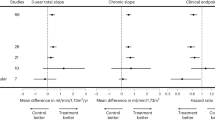Abstract
Methodology for assessing progression of chronic renal failure and performing and analysing trials has never been a favourite topic in nephrology. The aim of this paper is to discuss from a statistician's point of view the advantages and disadvantages of different direct (glomerular filtration rate, creatinine clearance, reciprocal and serum creatinine_ and indirect (need of renal replacement therapy, halving of glomerular filtration rate, doubling of serum creatinine) markers of renal function, and their statistical evaluation. The use of cross-tabulation, regression analyses/slope techniques and survival analyses for this purpose is discussed. Furthermore, a new approach for the evaluation of progression, the so-called progression charts, is described in detail. This paper reveals that analysing progression of renal failure is not an easy task. However, there are a number of pragmatic approaches which seem to be suitable.
Similar content being viewed by others
References
Gretz N, Strauch M (1984) Therapeutic effects of branched chain amino, and keto acids in uremia: methodologic aspects of planning clinical studies. In: Adibi SA, Fekl W, Langenbeck U, Schauder P (eds) Branched chain amino and keto acids in health and disease. Karger, Basel, pp 433–448
Gretz N, Strauch M (1986) Statistical problems in designing, conducting, and analysing nutritional trials in patients with chronic renal failure. Contrib Nephrol 53: 82–91
King AJ, Levey AS (1993) Dietary protein and renal function. J Am Soc Nephrol 3: 1723–1737
Giovannetti S, Barsotti G (1992) In defense of creatinine clearance. Nephron 59: 11–14
Hood B, Attman PO, Ahlmen J, Jagenburg R (1971) Renal hemodynamics and limitations of creatinine clearance in determining filtration rate in glomerular disease. Scand J Urol Nephrol 5: 154–161
Levey AS, Berg RL, Gassman JJ, Hall PM, Walker WG (1989) Creatinine filtration, secretion and excretion during progressive renal disease. Kidney Int 36 [Suppl 27]: S73-S80
Levey AS (1990) Measurement of renal function in chronic renal disease. Kidney Int 38: 167–184
Shemesh O, Golbetz H, Kriss JP, Myers DB (1985) Limitations of creatinine as a filtration marker in glomerulopathic patients. Kidney Int 28: 830–838
Acker B van, Koomen G, Koopman M, Krediet R, Arisz L (1992) Discrepancy between circadian rhythms of inulin and creatinine clearance. J Lab Clin Med 120: 400–410
Schumann L, Wüstenberg P, Hortlan B, Kühnle H (1993) Determination of glomerular filtration rate on two consecutive days using inulin in a single-sample plasma clearance method. Clin Nephrol 39: 65–69
Gretz N, Braun C, Strauch M (1993) Determination of inulin clearance by using a single-sample method. Clin Nephrol 40: 124
Böhler J, Glöer D, Reetze-Bonorden P, Keller E, Schollmeyer P (1993) Renal functional reserve in elderly patients. Clin Nephrol 39: 145–150
Böhler J, Woitas R, Keller E, Reetze-Bonorden P, Schollmeyer P (1992) Effect of nifedipine and captopril on glomerular hyperfiltration in normotensive man. Am J Kidney Dis 20: 132–139
Holliday MA, Heilbron D, Al-Uzri A, Hidayai J, Uauy R, Conley S, Reisch J, Hogg RF (1993) Serial measurements of GFR in infants using the continuous iothalamate infusion technique. Kidney Int 43: 893–898
Gretz N, Manz F, Strauch M (1983) Predictability of the progression of chronic renal failure. Kidney Int 24 [Suppl 15]: S2-S5
Manz F, Gretz N (1994) Progression of chronic renal failure in patients with nephropathic cystinosis. Pediatr Nephrol 8: 473–478
Gardner MJ, Altman DG (1989) Statistics with confidence-confidence intervals and statistical guidelines. Brit med J, London
Matthews DE, Farewell V (1985) Using and understanding medical statistics. Karger, Basel, pp 67–87, pp 148–157
Kalbfleisch JD, Prentice RL (1980) The statistical analysis of failure time data. Wiley, New York
Gretz N, Strauch M (1991) Low-protein diet and chronic renal failure. Lancet 338: 442
Fouque D, Laville M, Labeeuw M, Zech P, Boissel JP, Chifflet R (1992) Controlled low protein diets in chronic renal insufficiency: meta-analysis. BMJ 304: 216–219
Brown MB (1992) A test for the difference between two treatments in a continuous measure of outcome when there are dropouts. Controlled Clin Trials 13: 213–225
Author information
Authors and Affiliations
Rights and permissions
About this article
Cite this article
Gretz, N.M. How to assess the rate of progression of chronic renal failure in children?. Pediatr Nephrol 8, 499–504 (1994). https://doi.org/10.1007/BF00856550
Received:
Revised:
Accepted:
Issue Date:
DOI: https://doi.org/10.1007/BF00856550




